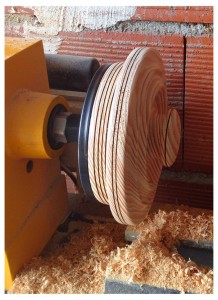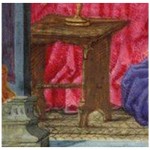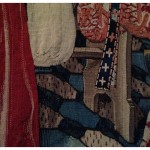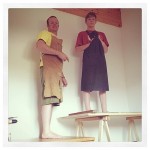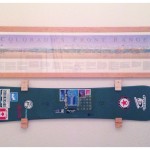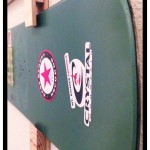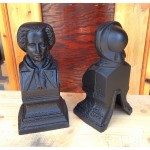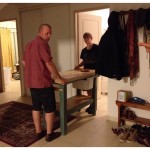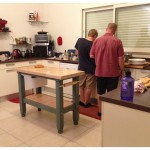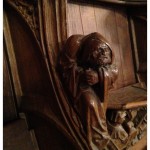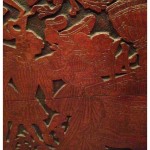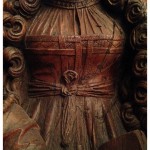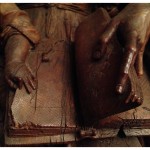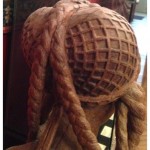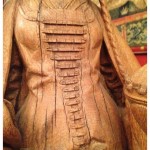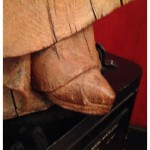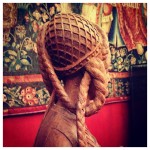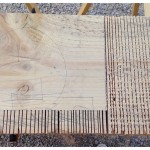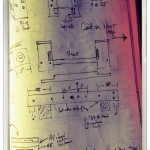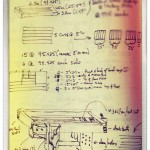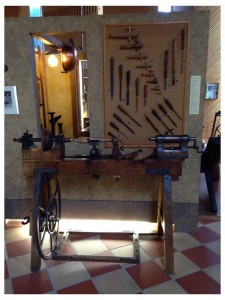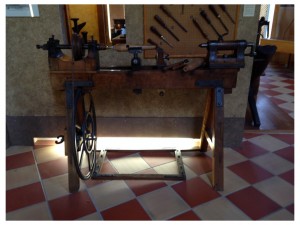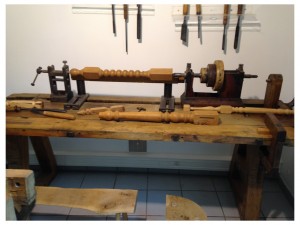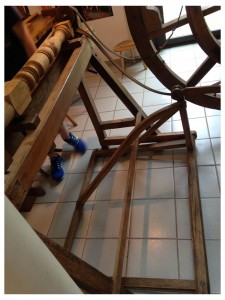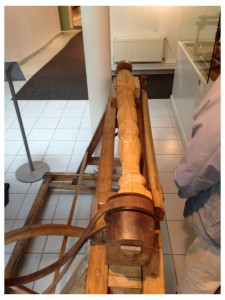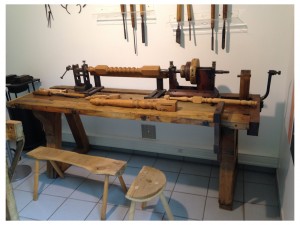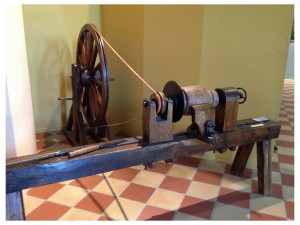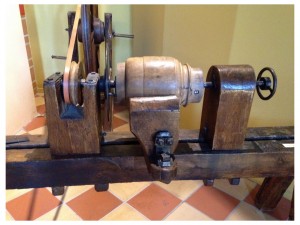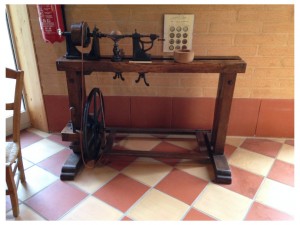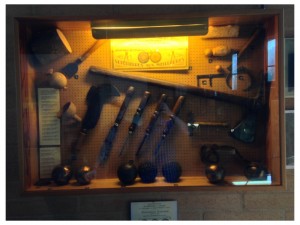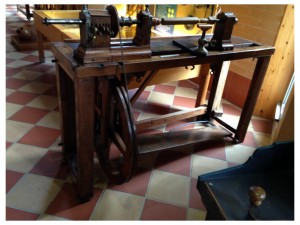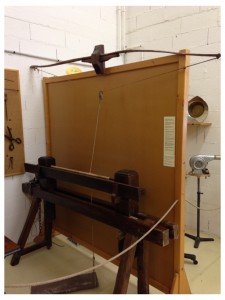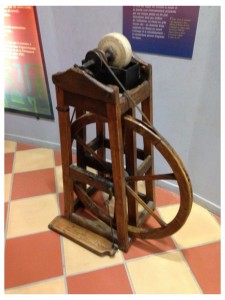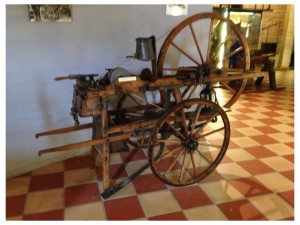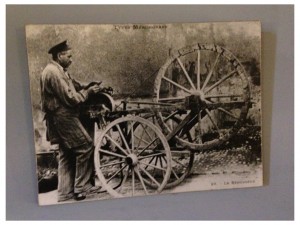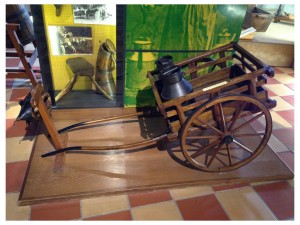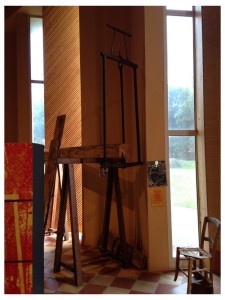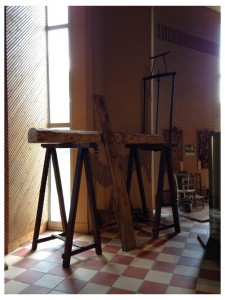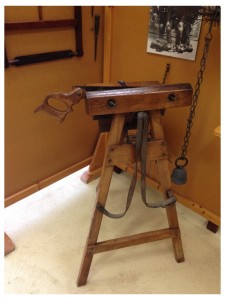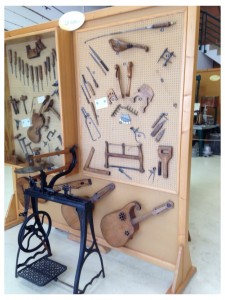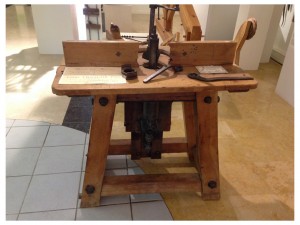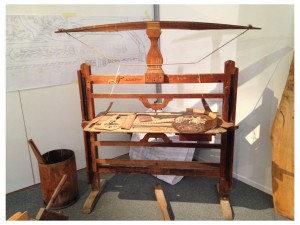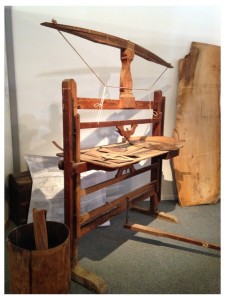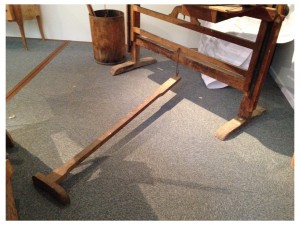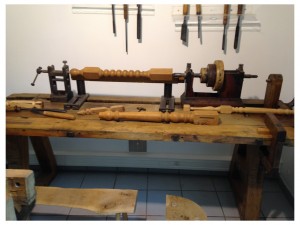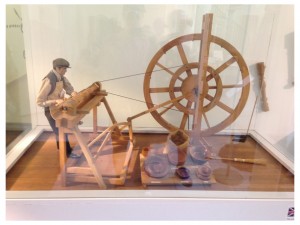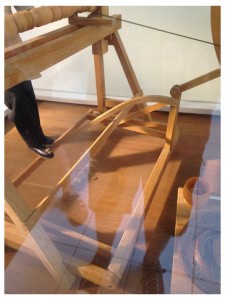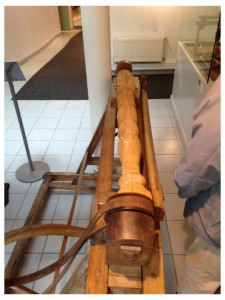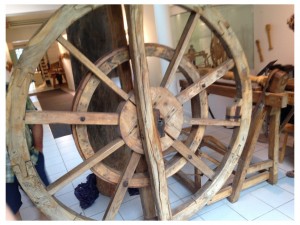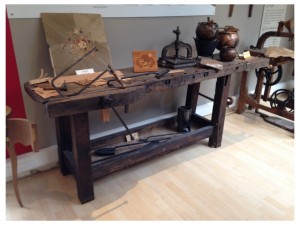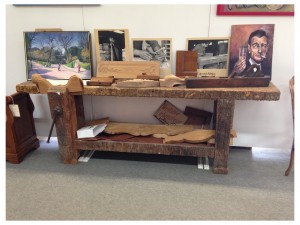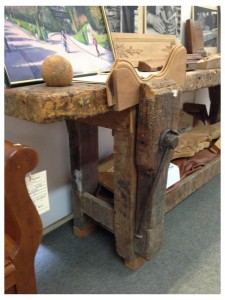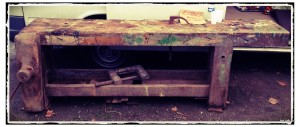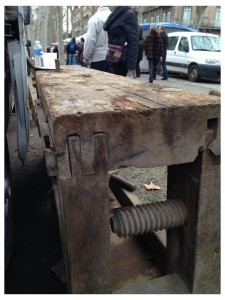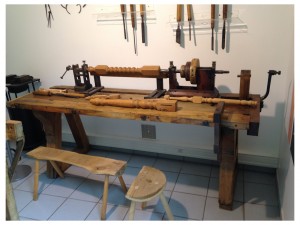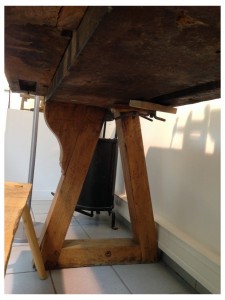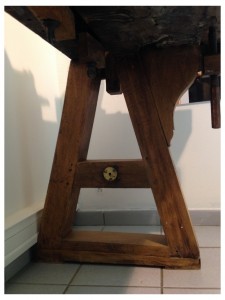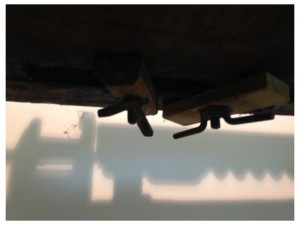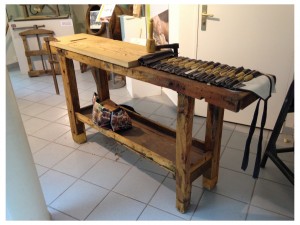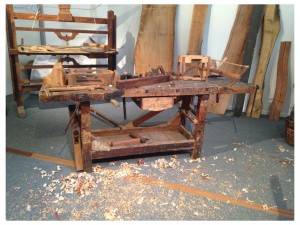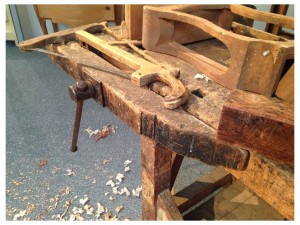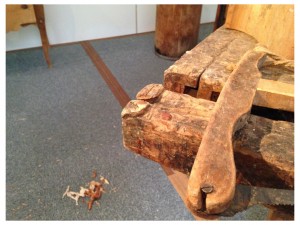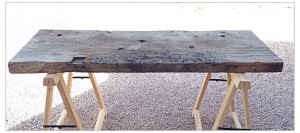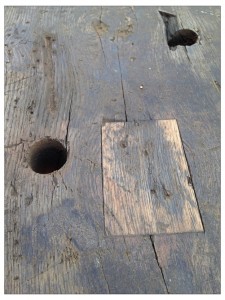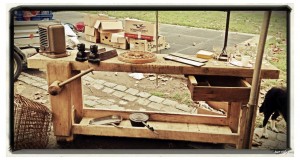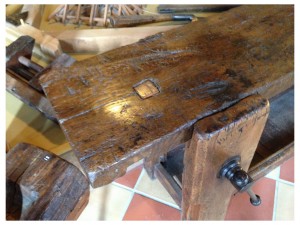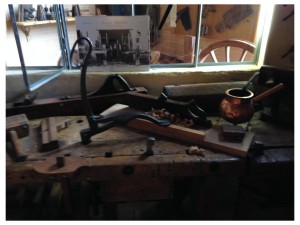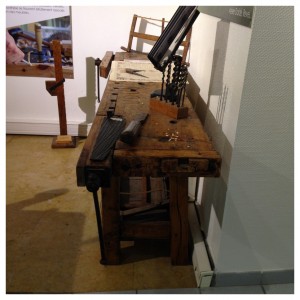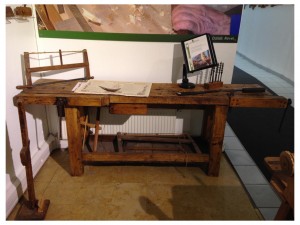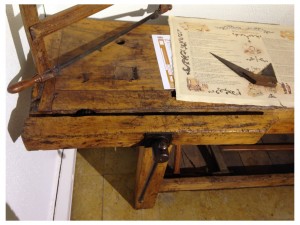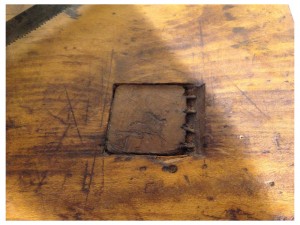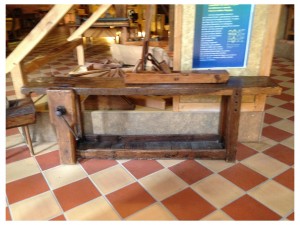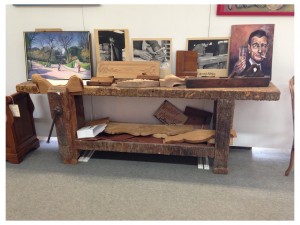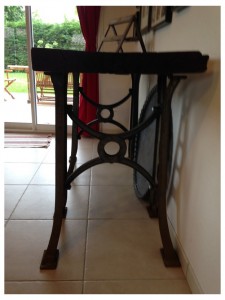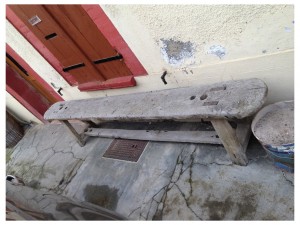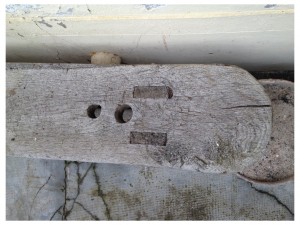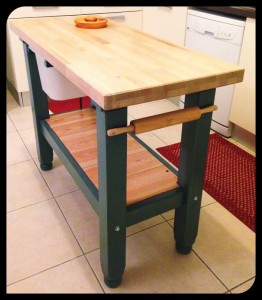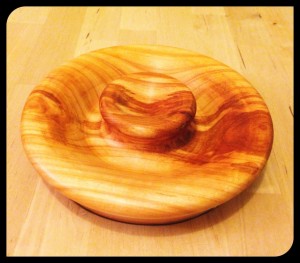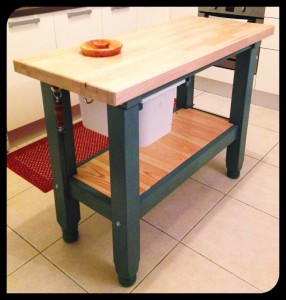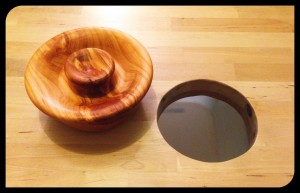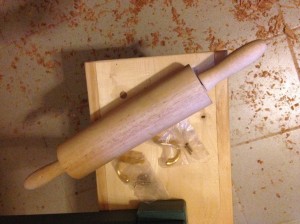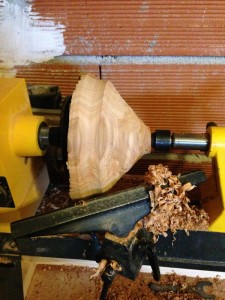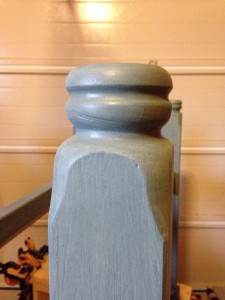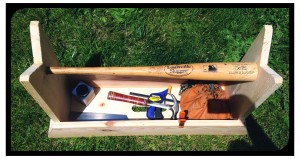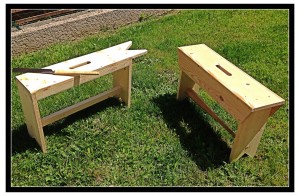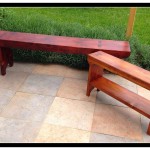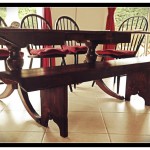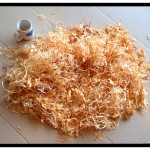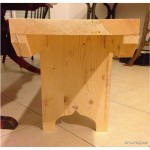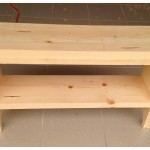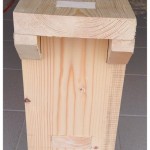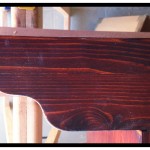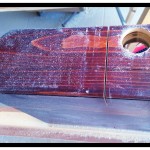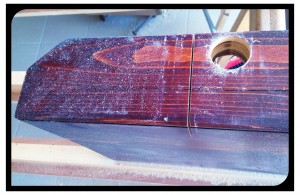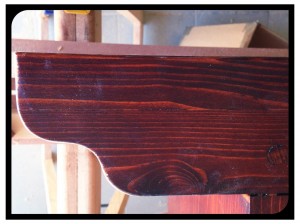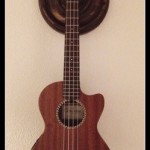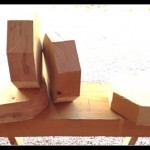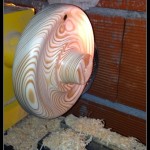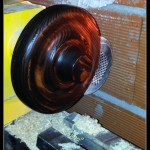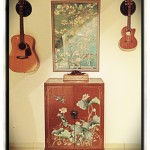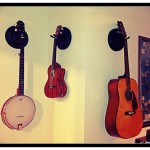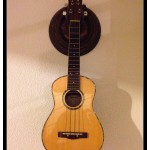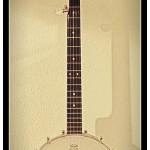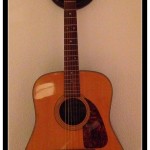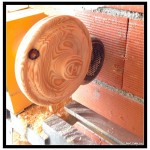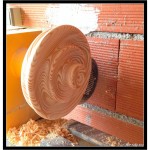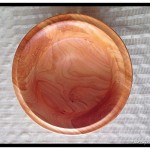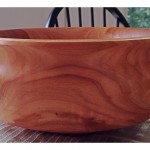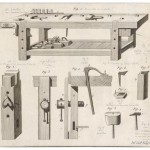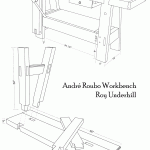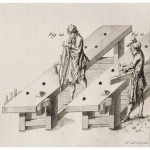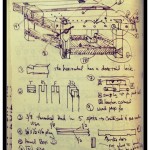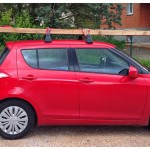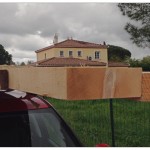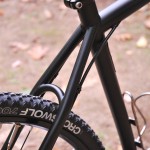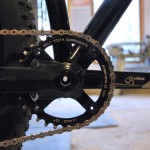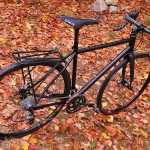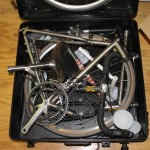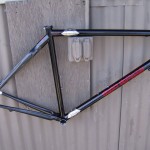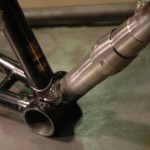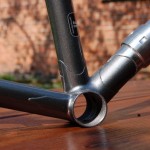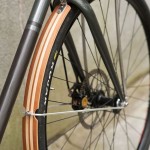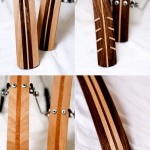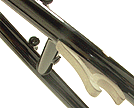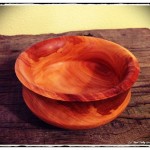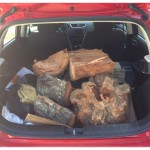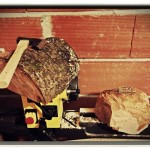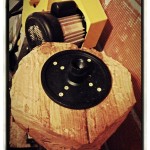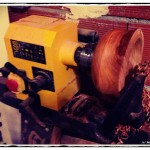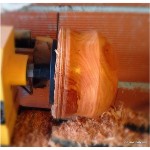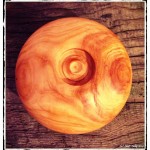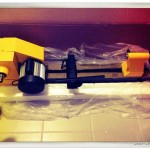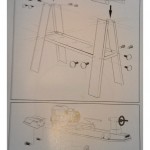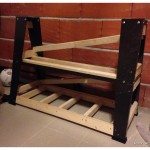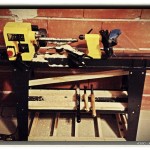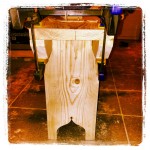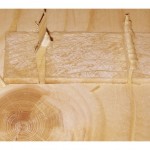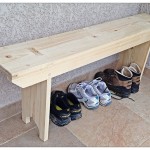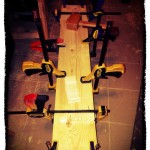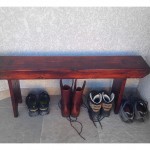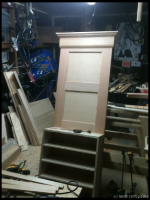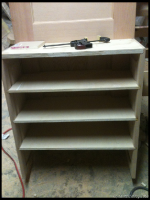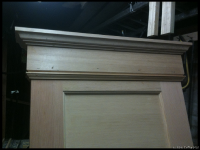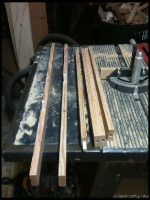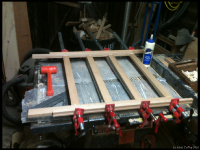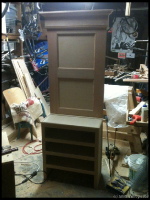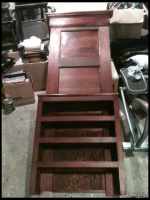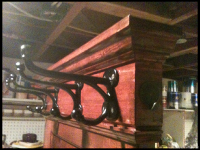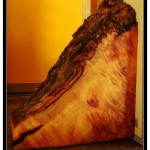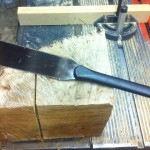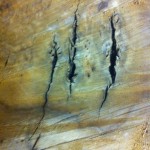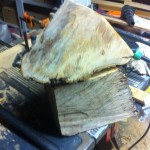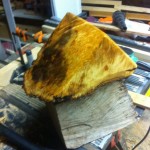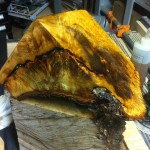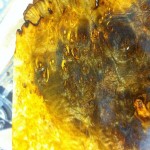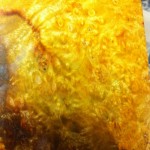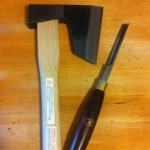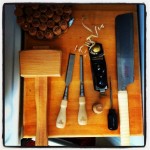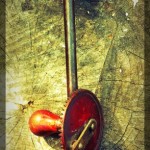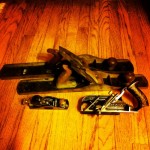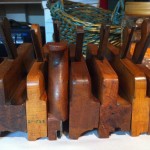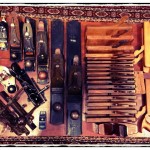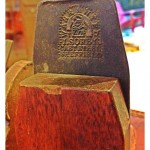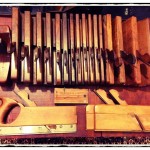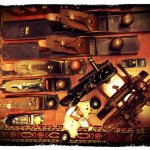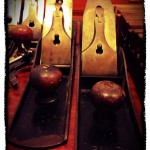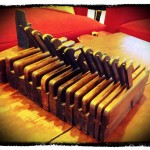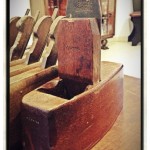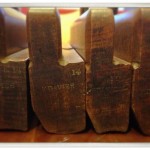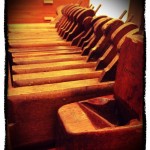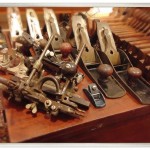We have a Art Deco flower pot in the guest bathroom that is used as a trash can. is about 9″ high and 8″ in diameter, so it doesn’t hold a lot. However, our new puppy is VERY interested in the contents of that vessel. To stem any possible and eventual messes, I took some pine scrap, chucked it up in the lathe and made a heavy wooden lid. I stained and finished to match the pot. Simple fast jobs like this make it so I can buy new tools without my sweet wife flipping out.
Category: Craftsmanship
Medieval Benches in Art
As I have mentioned in previous posts, I have been on a 5-board bench kick this year. I have built five so far and two more are in the works. I am also putting together at least three 6-board benches in the next 6-8 months, which share similar design and construction. Both items are classified as “Furniture of Necessity” or “Early Rustic” if you go shopping for one or the other. The patterns for them are roughly the same now are they were 2000 years ago and they lend themselves to hand-tool only construction.
I am not a Luddite that eschews a table saw, not in the least. I just don’t have one in France and am not buying one (If someone dropped off a new 10” cabinet saw and a compound sliding miter saw at my door, I guarantee that I could shoe-horn them nicely into the GROP). It has taken me almost 10 months to decide that I need a plug-in circle saw, but only to speed up the breakdown of thick planks and beams – I will be shopping at a pawnshop in the city though. I am just not spending the money to set up a new cabinet shop when we are leaving in a couple of years. Tools here are CRAZY expensive and most of the stuff available to non-professionals is crap. A Ridged-type contractors saw (bottom rung of what I consider acceptable for cabinet work) here with a real fence and a solid top will set you back the equivalent of $1100.00. Same saw at any Home Depot in the USA is about $500.00. A 7.25” Makita circle saw is the equivalent of $230.00 and an 18vt Ryobi drill with two batteries? $195.00!
Anyway, back to benches and chests… While in Paris last month we visited a plethora of museums and I kept finding little nuggets in the paintings, tapestries, and stained glass: top edge profiles, proportions, leg cutouts, etc… I am going to incorporate a couple of the details into my planed remaining work this year and next – just because I can. Below are a few of those details. They were for sure more to see, but not all museums allow pictures in their halls.
Film Friday – Merrill Guitars
Making stuff with My Son
It is one of my duties in this life to make sure that my children can do for themselves. Having to call a plumber for a clogged drain or an electrician to replace a switch just is not the Talley way. We are fixers, tinkers, builders, and warranty voiders by practice and nature. I cannot have it on my conscience that such a path would end with me, so part of the summertime ritual is to fix and build stuff.
This year was no different. The Ruminator work on the lathe a bit, helped me build a kitchen island, and helped design and construct a hanging shelf system for my wife’s sewing room. We hung a storage rack in the garage, built a snowboard rack for his room, hung stuff up in the living room, applied a little spray paint and finish, learned about milk paint, refurbished a miter-box saw, cut up some andirons, went over tool identification, sunk a bunch of screws, put some all-thread to use, made sparks with the grinder, and that sort of thing.
Just little bits at a time… Next year we will do a little metal work and wood carving. The year after, we might build a deck and do a little welding. At some point he will learn to sew and mend a little – not to be a seamstress, but enough to make simple stuff and put a button back on a coat. If he wants to be a carpenter or a cobbler or a tailor or a machinist or a welder fine, then I am equipping him with early skills to build from. But if he wants to be an architect, teacher, engineer, lawyer, doctor, or whatever – I still want him to have the knowledge base of how things work, how they are put together, and how they should be fixed.
UPDATE: Shortly after my son left to go back home, I was cleaning up the GROP and I found this message below written in saw dust. It made me both humble and very proud.
Film Friday – Ellis Mandolins
Wood Carvings at the Cluny in Paris
We spent 3 hours at Musée de Cluny (Musée national du Moyen Âge) in Paris on a recent trip. I highly recommend the little museum and the adjacent garden. While I enjoyed the tapestry and armor and paintings, it was the wood carvings that really stood out. The detail… Braids, carved folds in the dresses, miniature figures and scenes in a triptych that were beyond belief, fingernails, pages of a book… All carved in 400+ year old oak. Astonishing.
Side note: the plums in The Unicorn Forest (forêt de la Licorne) section on the garden were ripe and falling. I tried one ant it was delicious – upper sweet and deep blood red. They will make terrific jam. I may have brought 10-15 plums home with me and extracted the seeds. I plan to plant a few in a local forest and I have a sneaking suspicion that a very similar tree will grow in our yard in Seattle and in a friend of ours yard in Portland…
Cornebarrieu Bench – Redesign & first cuts made
I did a full redesign of the Cornebarrieu bench… As per my normal modus operandi, I was over designing/building it. With all the tweaks and gadgets and new parts, it was going to take me 6 months to build, some serious math to layout the interlocking joint angles and cost $1900 in material – I may have priced solid 4” thick seasoned Eastern European beech and walnut for the top and legs…
Anyway, I came to my senses and decided on using the pine I had already purchased for the legs and stretchers, lap joints with bolts instead of compound dovetails, a liberal amount of hide glue here and there, and a top made from re-purposed IKEA counter tops and will install a leg vice salvaged from a junk shop near Limoux, France instead of the $300 Benchcraft scissor vise that I was eyeballin’. The top will be solid all the way across instead of the split-top design.
The pine slabs have been drying in my GROP for 5 months and were ready to be cut down into their rough size. I had a little time this last weekend and spent 4 hours making all the leg and stretcher joint cuts – hogging out the material with successive circle-saw cuts and then chiseling them out. I am waiting to cut the tenon that fits into the top on each leg until I have the top in-hand. I chiseled and planed all the joint cuts smooth and I really wished I would have had a timber framing slick. When I do another bench or some large furniture with this type of joint anytime again, I will pick one up as it will pay for itself with the labor saved, in comparison to a 1.5” bench chisel, on 4 lap joints. I did the rough math and I think that I will have made 1023 total handsaw and circle saw cuts by the time the bench is done. There will be 16 bolts, 6 sections of 7/16” all-thread, 12 large screws, one 2’ ACME thread rod, 2 large dowels, 4 lag screws, 32 nuts & washers, and some sweat, blood, and curse words that will all go into it by the end. The new dimensions of the bench will be 25.5” wide, 34” tall, and 8.2 feet long. I believe the finished weight will be around 320 pounds.
My next milestone is the dreaded IKEA run. It will be a couple of weeks before I have the enough spending money horded together from my allowance (I want to be debt free in two years and retire at 55 so yes, I have an allowance…) and get the top cut out and fitted. I will update as I go.
Very Productive Weekend – except in the yard.
I did not mow the yard this weekend. It just didn’t happen. I meant to and I wanted to… I even took the mower and cord out, but it just didn’t happen. Instead I did this:
1. Redesigned the top of the workbench that I am building.
2. Threatened for 148th time to quit Facebook.
3. Didn’t quite
4. Updated status
5. Cleaned and organized GROP a little while grumbling about my lack of willpower
6. Worked on a J-O-B related spreadsheet
7. Finished bookends for wife – made from Victorian andirons.
8. Cut the base (legs and stretchers) for my workbench.
9. Turned two sets of TINY rosettes for our neighbor to replace a couple that are missing from a piece of furniture – help the neighbors when you can.
10. Put together a set of I-beams to reinforce a table top that is warping – they do that after 250-300 years…
11. Gave my wife a foot rub.
12. Glued up some maple blanks to turn later on
13. Played with the puppies – there are two now.
14. Got sucked into Pinterest
15. Watched a little TV/YouTube
16. Took puppies for a walk around neighborhood
17. Turned a small jar lid for wife out of some scrap cherry
18. Drank some Spanish rosé with wife and had a nice home cooked Thai meal
19. Fixed front door lock at 1:00am
20. Had weird dreams Saturday night
21. Slept in – new puppy had first good night’s sleep 🙂
22. Puppy sat while wife got her hair cut.
23. Told wife her hair was very pretty
24. We took puppies into Toulouse to meet some friends for coffee
25. Walked in park with wife and puppies.
26. Cut and chiseled joints in to ½ of the workbench legs
27. Sucked into Pinterest vortex again
28. Sent some J-O-B e-mail
29. Talked to my mom
30. Text messaged with my daughter
31. Tried to call my son – he was out with friends. Teenagers… 🙂
32. Played with puppies
33. Sent some more work-related e-mail
34. Told wife hair was pretty again
35. Made a tiny adjustment to kitchen island at wife’s request
36. Wrote a snail-mail letter to my aunt and son
37. Filled out a couple of post cards
38. Updated website a little
39. Looked at work calendar for tomorrow – very full.
40. Said dirty words…
41. Went downstairs to snuggle wife, puppies and to stay up too late on Pinterest or stupid Facebook.
Film Friday – Romero Banjos
Before Electricity – French machine tools that were/are human powered
As we have traveled a bit here in France, I have drug my wife, son, in-laws, and friends to dusty museums and shops to see some amazing examples of traditional French woodworking tools and machines. These bits of pre-electric woodworking gems have been covered in beasage, wabi-sabi and love. Some were almost pristine, looking like there were used the day before and a few are shadows of their former-selves, but beautiful none the less. There are lathes, marqueterie saws, Saw-tooth sets, sharpening stones, carts, presses, saws, etc…
One of the most prominent things I noticed were all the different mechanisms for making the different lathes go ’round: peddles, treadles, hand operated flywheels, waterwheels, and bows.
Enjoy
Historic French Work Benches
In the 7 months I have lived in France, I have seen some amazing examples of traditional French carpenters’ work benches. They are full of tool marks, tool trays, attachments, vices, dog-holes, studded plane stops, nicks gouges patches, etc… Some are almost pristine, some covered in 100+ years of marqueterie glue, and some rotted – full of worm holes. One some you will see the standard “French” leg vice and others have a parallel top vise – also don’t know what to call it – is a southern French/Basque sort of thing. I asked a local “old guy” here and he said was a “thing” here. That is the direct translation 🙂
Almost all the benches I see here are slab benches and a number are slab benched with a thick dadoed plank bolted to the front edge to provide square dog holes.
As a man who appreciates such things, as a joiner in the process of building my own bench, and as a tourist in a foreign land I have been busy with my camera. 🙂 Below is a data-dump of some of the better benches and details that I have seen so far. I will update as I see more in the “wild.”
Side note: I bought a couple and am having the gassed (wood worms are serious here!) and will be bringing them back to the US when we rotate back in a couple of years – one for the house and one for the shop (tall oak slab for dovetail cutting) and IF there is any room in the container I may bring back a couple more – just because my wife hasn’t said no :-).
Chopping Block Kitchen Island – IKEA Hack
Stamps-With_Foot has wanted a chopping block island for years. Our kitchen in Seattle just didn’t have the room for one, but the kitchen in France was PLENTY big enough. I looked into taking some 5/4 maple and gluing it up for her, but without a table saw and a power planer it would have been REALLY difficult. We found a couple that were already built, but they were between 400 and 900 Euros. No.Thank.You. After some deliberation, I decided on an IKEA island – the Groland. Stop Laughing and put down the stones…
While my son (The Ruminator) was here in France on his summer vacation, we bought one in a box, strapped it to the top of the car, drug it home, and started putting it together. I couldn’t leave it stock though, that is just not how I operate 🙂 We added a few flourishes to make it “better.”
1. Turned the legs on the lathe to give it bun feet
2. Glued it all together and added some extra dowels for reinforcement
3. Removed the steel rods on the original and plugged the holes with Dowels
4. Painted the base with a Sea Green Milk Paint
5. Added an additional block section to the bottom of the top panel – to make it super-solid
6. Cut a 6″ hole in the top for sweeping scraps off the work surface
7. Put a large plastic bin – removable from both sides – under scrap hole
8. Bolted rolling pin to one side to towels and placed 2 brass hooks on the other side
9. Scrapped the wood lattice bottom panel and used 7/8″ tongue and groove clear pine decking boards instead.
10. Polyurethaned the top – 5 coats – and bottom shelf so they match and make the painted base “pop”
11. Took a hunk of cherry tree trunk and turned it down as a lid for the scrap hole.
My Son and I had it installed just in time for my chef Father-in-Law, The Chatty Buddha, to visit and whip up a few fine meals using it as a work platform
a couple of saw benches for the shop
I needed a couple of saw benches for my GROP, so I put a together two of different designs. They are both simple, plain and sturdy – no nails or screws, just glue, dado joints, and oak dowels. One is an old V-notch pattern that I have seen 1000 times and the other is combination bench/tool tote of my own design. I made the tote handle of the second one from a baseball bat that was cracked. I turned down the ends on the lathe to make 1-1/2″ round tenons and captured the tenons with wedges and 2 dowels – placed at 6:00 and 12:00 as keys. This permanently locks the bat and will keep it from twisting loose. the Louisville brand is facing up when carried – It adds a little flair to something that would normally be utilitarian and is big enough to carry everything I need to do a household fix/honey-do.
A Bench Building Machine
In addition to the 5-board bench by our front door, I have built a large bench for our dining table and one for our entry-way with shoe storage, per my sweet wife’s request. I have a couple of saw benches for the GROP and 2 narrow ones for my office all cut out as well, but not put together. These benches are traditionally “furniture of necessity” and not meant to be fine furnishings, but I think that there is still beauty in their simplicity and usefulness (useful and helpful are the highest Talley-family compliments). Additionally, they are simple, cheap to build, and lend themselves to hand-tool only construction. Not a single screw or nail is used: I used through-tenons, oak wedges, and dowels. With almost instant tangible results, the whole process in building these is therapeutic. When and if I have a super-crappy day at my J-O-B, I can go into the Garage/Shop/GROP after dinner and make some wood shavings and improve the bejesus out of my mood. Cheaper than counseling and less bloody than a rampage 🙂
7/3/14 Update:
So… The bench built for the dining table had ends that extended a little too far from the legs. It made the bench tippy if someone either sat on just the end or got up with someone also sitting on the other end. There were a couple of incidents where a butt almost hit the ground. I removed 7″ from either side and changed the stretcher detail a bit as the plain 45 degree cut didn’t really match the curl detail on the feet.
Film Friday – The Potter’s Wheel – 4/25/2014
Guitar and Ukulele wall mounts
One of the last things to deal with at our place in France was all the stringed instruments propped in corners or laying precariously on top of furniture. I wanted them out in view so they would be played instead of put in a closet somewhere, forgotten about. We want a home that is filled with music and if there is a loaner guitar or uke (LOVE the ukulele – have two) about, someone is going to pick one of them up and strum a few cords. There is nothing like a cool evening, sitting outside after a BBQ with someone softly playing a tune or two. I looked at a couple of commercial wall mounts that were pricey and didn’t really go with our decor and decided to make my own. I am sure they would look great in a studio and there was one model that would have been killer in my 15-year-old self’s poster-filled bedroom, but nothing I looked at screamed “hand-crafted” or “classy.” I went through a couple of ideas in my head that wouldn’t have really worked out for various reasons before having a light bulb moment while on a work trip in China: scrap wood + my lathe + U-hooks and some silicone tape = sweet instrument hangers that both blend with our home AND that no one else has.
This past weekend (Easter holiday), I cut five octagon blocks out of some left-over 5 inch thick pine timber and rounded the first one on the lathe. It was meant to be a prototype so I free-handed the curves without really having a design in mind before I started. It looked so great after the stain and wax went on that I took it right in and mounted it to the wall. I turned the others all with different patterns and hung them in a living-room hallway that has an awkward corner. They look great there – if my opinion counts for anything. Now there is room for 2 ukuleles, an acoustic guitar, an electric cigar-box blues machine, and a resonator banjo.
I am working on a Uke hanger for my home office as well. I spend 10+ hours on my computer or on the phone and find that it helps if I can take a little break or strum while thinking about a technical problem that is pissing me off. I wouldn’t be able to do that in a cube.
Another Cherry Bowl
I started it out thinking it was going to be a different shape, but due to some spongy fruit-wood, it became more of a vertically sided bowl with a deep finger groove on the bottom. Like the last bowl (and most of my bowls and lids), I turned a little detail in the bottom of the bowl because I think that curiosity should be rewarded. The bowl is again finished off with my own mix of beeswax and walnut oil. I am going to let it dry for a few months and reapply.
]
Film Friday – Paddle Triple Feature – 4/18/2014
Canoe Paddle Maker
Hand Crafted from Jam Jar Films on Vimeo.
A Cherry Paddle
My Paddle – Luke Gibson from Luke Gibson on Vimeo.
Hawaiian Paddle Maker
A Fine French Work Bench
My GROP (garage and shop combo) in Seattle was too small for a proper joiner’s bench. I made due with a slim, high, wall-mounted work counter, a bolted on machinist-vise, Quick Clamps, and the top of my table saw. It worked – mostly – but was a pain in the ass a good bit of the time: I never once planed a board on a stable, solid surface. My GROP here in France is roughly the same size as the one in Seattle, but is absent the huge cast iron machines and saws. I have some room to move and finally have the space for a big, heavy, proper work bench. This shit is about to get real…
As I live in France, I am building a 2m long, 85cm wide split top Roubo-style bohemyth, that will have a 12cm, 4-part slab top (6.5′ X 33.46″ X 4.72″) and it will be 36″ high as that is MY optimal bench height. Wooden leg vise, dog holes, a cast iron tail vise – all the bells and whistles! I am planning for it to take a mule to move this thing as I will do some serious planing on this baby. It is an amalgamation of benches by M. Roubo, Roy Underhill, Chris Schwartz, and Bill Schenher. I am calling it the “Cornebarrieu Bench” after the small village in southern France where we live, where the lumber has been sourced, and where the bench will be made and first used.
I picked up some of the lumber at a yard near the house (still need the top – thinking of Beech!), strapped it to the top of my tiny car and carried it home, giggling manically. The wood is now in the GROP drying out a little and waiting for me to attack the timber and fashion it into one fine, sweet hunk of usefulness. It makes my black heart more than a little happy to think about the look on movers’ faces when they see this thing when they come to pack us out for our eventual move back to Seattle. Mwahahaha…
Film Friday – Shoes – March 21, 2014
Bespoke Boots:
George’s Boots from farmrun on Vimeo.
A Family shoe business:
E Vogel {Custom Boots and Shoes} from Davide Luciano on Vimeo.
Danner Boots:
Crafting Higher Standards Trailer from Haven Anderson on Vimeo.
Resoling:
Recrafting: Crafting Higher Standards from Haven Anderson on Vimeo.
What I want Thursday – A Someday Custom Bike build
Someday, I will have a bespoke bike built – custom fit to my goofy measurements and with all the bells a whistles that I want/need/lust after. A bike that is equally suited for using as a city single-speed, a gravel road shredder, light single track, and a 9-speed road rider and tourer.
I want:
A lugged steel frame
S&S couplers so I can fly with it
Disc breaks
Single front 32T or 44T chain ring
18T freewheel (I have an Ultegra 9-speed group and Deraulier in a box…)
Clearance for 33X700 tires
Bull horn bars
Paul 2-finger levers
Flipping Rear dropouts (44 Bike)
Duel bottle cage
Rack and fender mounts (I have a set of wood FastBoy fenders that need a good home)
Brazed on bottle opener (A’la Rodriguez Cycles)
Brooks Swallow Tail saddle.
I really dig what Kristofer Henry in New Hampshire has going with 44 Bikes. If I could talk him into a lugged Huntsman, then we could do some serious business.
From tree to bowl with a LOT of sweat in between
I have a colleague that was making over a large section of his property out in the French country-side and he needed a dying cherry tree taken down. It was a big old tree with what looked like lots of good hard wood in the trunk base, so I gave him a hand. I thought I could tun the wood into some nice bowels, mallet heads, honey dippers, etc… and he agreed to let me have some of the wood that was destined for his fire place. Holy Crap it was work – not at all helped by his tiny electric chainsaw. It made me long for my 30″ bar, 2-stroke beast back in my Seattle garage shop.
After cutting 2 good rounds and trimming up the root ball, I split the rounds in two, then put 200 pounds of wood in the back of my tiny Suzuki Swift and hauled it home. Into the garage it went and the wife and I were off to the Saturday Market. I came back to one of the rounds on the next night and decided to prep it for turning. With my Japanese hatchet and hand saw, I worked it into an octagon-ish shape. There was a lot of rot in the outer rings and the sections did not make as large of bowls as I had hopped, but the root ball will make an AMAZING centerpiece on the table for holding bread or fruit at parties. I am getting ahead of my self a little…
Anyway, the first section was a beast! It took me 3 hours to go from the half-round to the round bowl-blank. I almost threw the hunk down and took it over to my neighbors wood pile while just roughing it into shape with the axe. The wood was SO FREAKING HARD! It got worse when I started spinning the thing! My roughing gouge was super sharp when I started and I had to sharpen it twice again during the initial turn. There was a break in the turning where I built a jig for my turning chisels so that the sharpening angle was perfect every time, but that is a different tale…
I have never gone from tree to bowl before and I wanted to see if I could do it well. Usually, I either glue up hardwood scraps or buy a rough elm or maple blank from my hardwood dealer in Seattle (With the coin I drop at his place, he is most assuredly a DEALER! His crack just has figured grain and tight growth rings…) Anyway, I might should have picked a tree with softer wood for my first time, but how many turners back in the US can say that they cut down a old cherry tree in France and made cool stuff with it?!
I finished up the bowl four nights after I started turning the rough shape. I had to work around some rot and cracks, but the final shape turned out really nice. When someone handles the bowl and flips it over, they will find my makers mark and I turned a little detail in the bottom of the bowl because I think that curiosity should be rewarded. The bowl is finished off with my own mix of beeswax and walnut oil. After two coats, it colored up beautifully. There are a couple of spots where it may split along the rim, but that is just the nature of the wood and that specific piece – it will add character to the bowl. This one was done for the guy who gave me the wood and I will turn a couple later for our house.
I was really proud of how it all turned out and the final product made all the sweat and cussing worth it.
Film Friday – Wine Double Feature +1 – March 14, 2014
California:
“Under The Vine” from Stephen DaVega on Vimeo.
France:
A VERY PRIVATE VISIT AT CHATEAU LATOUR from jf julian on Vimeo.
+1 – Old School way of making a Wine Barrel:
Making of a wine barrel – Francesco Loi from Francesco Loi on Vimeo.
How to make a Chinese wood lathe work “right out of the box”
I have mentioned that when planning our move to Toulouse, I realized that I would have to leave my big electrical shop machines in Seattle. It hurt a little as I have become dependent on a table saw and compound miter saw for even the simplest tasks. I am looking forward to spending some quality time with my hand tools, but I have to have a lathe to complete 75% of the projects that I tackle. There is no way in Blue Blazes that I am was going to build a pole lathe or a foot-powered flywheel lathe – there I draw the line. I needed a fairly large machine to turn the posts, trenchers, stools, bowls, table legs, spindles, scoops, etc… that are on my “to-do in France” list.
Machine tools in France are CRAZY expensive. Look at the US price, change the Dollar sign to a Euro sign and add 30% to the final price. I looked at a large Jet lathe and it cost more than my first truck. Even the small midi version was the equivalent of $600. I just can’t spent that kind of cash on something that doesn’t either feed me or take me to work. After some research, I found a bare bones, no accessories, Chinese made model that some of the local turners were buying for their second or third lathe. It was 1/3 the cost of a well appointed model with the same bed length and power. Sold. I brought all my chucks and jigs and accessories with me, so I thought “Perfect!”
There wasn’t one available in a 400 mile radius, so I had to order it at the home center in the next village over. 11 days later it showed up and I brought my new 400 pound beauty queen home in a Suzuki swift. I am sure the douche-bag that stood 10′ from me watched as I man-handled it into the rear hatch of my tiny car using old tires and 2X4s has already posted the video.
Now, it was advertised at “Ready to turn out of the box!” For that to be true you need the following tools:
- Rubber Mallet
- 1/2″ combination wrench
- Set of standard Allen wrenches
- Flat-head screwdriver
- #2 Phillips screwdriver
- 3/8″ drive ratchet
- 1/2 socket
- Long socket extension: >6″
- Standard Tap and Die set
- A large vocabulary of cuss words
- Drill
- Metal Drill-bit Set
- Large Bastard File
You will also need the following additional parts as the bolts and washers provided were likely scooped from a bin without counting and dropped in a bag. There are only two small pages of instructions and they do not list all the parts, the number of each that will be required, or the order in which they are installed. Take examples of the bits and pieces provided and get duplicates in the same size:
- Washers
- lock-washers
- pan head bolts
- Machine bolts
You will also need:
- four 8′ long 2X4s
- Wood Glue
- Sandpaper
- Pan-head wood screws or deck screws
- 4 sacks of concrete
I found out about the hardware issue right away and drove back to the home center in the next village for spares, but I had all of the other supplies on hand – I did not pack light for our move here 🙂 The base was my first obstacle. It was flimsy sheet metal and some of the holes were out of alignment. I drilled and fitted, whacked with a mallet and said lots of dirty words, before I finally got the lathe on. A quick tug showed that the base needed some serious beefing up. If I put an unbalanced piece in it, it would shake apart. I ended up building a crossed braced wooden skeleton for the whole thing – my Jr. High Wood Shop teacher would beam with pride. The reinforcing process took me 4 hours that first night, but that was mostly because I don’t have a miter box saw and was making compound angle cuts with a sliding-T bevel and a Japanese pull saw. I ended up having to chase the threads in the cast iron lathe bed and on the head stock (really) with a couple of different taps and used Loctite on all the bolts.
All the handles and knobs had to be put on and tested and the tail stock and head stock had to be adjusted, tweaked, and tweaked a little more to get them in alignment. The cast iron tool rest was really rough, so I used a file here and there on it and sanded the tool bearing surface and finger groove with progressively finer sandpaper, from 80 to 400 grit. This all took another 3 hours the next night.
After all was said and done, I clamped up a small hunk of 2X4 that was a cut-off from building the base and with just my skew chisel, turned it down and into a bunch of tiny beads. The lathe turns great and has plenty of power. I couldn’t be happier. I saved 800-1000 Euros in exchange for 7-8 hours of me time.
Bench for the front entry – Project #4 in France
We are a “no shoes in the house” family. It is dry and dusty where we live in the summer and the trails near by that I run and that Stamps-With-Foot and Brodie walk on are shared with horses. We don’t want to track dirt and poo into the house. There is a great spot right by the front door to take your shoes off, but no place to sit down to do it. I decided a rustic little 5-board bench was in order. I spent five hours from the initial sketch design to putting on the final coat of polyurethane over a week’s time. No nails or screws were used, just through-mortises, wedges and dowels. We now have a small piece of furniture outside the front door that is functional and matches the house and the style of our other furniture – you never know it might someday find its way inside.
Film Friday – Chair making – March 7, 2014
This is a long one, but really detailed…
The Sterling Historical Society presents PeterGalbert from Robert McKay Jones on Vimeo.
Hall Tree and Shoe Rack for My Bride
Soon after we moved into La Maison du Talley in Seattle, my lovely bride decided that “we” needed a place to hang coats by the front door. I looked a little at coat racks and hall trees in the shops close to the house, but I just couldn’t stomach paying $250-300 for a semi-crappy coat rack that was the wrong color or wood for our house. I had one of those “light bulb” moments and decided to build one for us. Normally, I would have cut the raised panels (I tried to convince Stamps-With-Foot to let me do linen-fold panels) and added a little fancy trip work, but as I was recovering from shoulder surgery (#4), I decided to go with the re-use route. Second Use is a used hardware and reclaimed building material store in Seattle that I frequent and I cruised over for a used fir 6-panel door. Right away, I found the perfect one that set me back a whole $30. While pushing the cart loaded with the door to the front, I found a couple of cast off cabinet doors, a few odd sections of trim, and a bundle of old tongue & groove fir flooring. A plan formed in my little head…
I cut two feet from the top of the door, then flipped it over. I built a bench and shoe rack from the cabinet doors (raised panels turned in to match the adjacent hutch and the flat panel cabinets in the rest of the house) and attached it to what became the bottom of the door/hall tree. I ringed the top with a flooring plank, tongue down, and then applied some 100 year old left over fir crown molding on the top. The whole thing was sanded down and stained a deep red mahogany and finished off with 3 coats of exterior grade polyurethane.
For the hooks, I sourced a set of coat and helmet hooks from an old Seattle firehouse and small round dog leash hooks from Rejuvenation Hardware. When all was said and done, this was the very first project finished for our home in Seattle, I spent a total of $94, and I wrote a little love note to Stamps-With-Foot on the top of it. My little wife was giddy when I brought it into the house and she raved to friends for weeks about handy and awesome her husband was – made me puff out my chest like a Banty rooster.
If I did this again, the only thing I would change would be to make the shoe shelves movable as they are about 1/4″ too narrow for my running shoes, but perfect for her shoes, which I guess is the most important feature.
Last Project in Seattle Shop for a While
Just before we left Seattle for Toulouse, Stamps-With-Foot and I went to San Francisco to secure our French Visas. While there, we spent an afternoon visiting friends and family. At one point, we found ourselves at my wife’s non-biological little sister’s house (Becca) and I noticed a couple of chunks of wood sitting out on her patio. My wood lust made me wonder over and take a look… HOLY CRAP! She had 4 huge chunks of Aromatic Cedar Burl – like $450+ in exotic wood sitting out in the rain. I immediately ran inside and told her to get it on eBay right then. She and her husband found the chunks sitting on the side of the road with the trash and just picked them up. I tried explaining to her how awesome and rare her find was, but Becca didn’t really have the will/time/interest to sell the pieces to some other lumber-jock and I was told to take some home if I wanted it.
I argued.
I tried to tell her how to sell it.
She was firm.
What was I to do??
I packed two hunks into a diaper box, taped it up, and checked it as luggage on the flight home.
The wood was a little wet still, but I couldn’t help myself – I HAD to cut into it to see what the figure looked like. I was a little heart sick on the first cut when my saw hit rotten heart wood. I managed to cut out a few (6) big wedges and a couple of blocks. I sanded one of the wedges smooth and applied a little walnut oil and OH MY!! I do not believe that I have ever fallen in love with a hunk of raw wood before that instant! I didn’t have the time to really do anything detailed, so I cleaned up the two sanded wedges and brought them in the house for bookends and left the other bits to dry and season in the garage until we move back and I can give them a some proper attention. I will make a little lidded bowel for Becca and maybe some bookends out of the other sections for her dad.
Film Friday – Book related Double-Feature – Feb. 28, 2014
Tools I brought with me from the old country…
When planning our move to Toulouse, I came to the realization that I would not be able to take my entire shop with me. I didn’t relish the idea of replacing all my power tools and saws with 220vt/60Hz versions, only to have to sell them in a couple of years when we move back to Seattle. I decided that I would bring mostly my hand tools and and spend some quality time working small projects, cutting dovetails, tuning my planes, etc… There were three 24″X24″ boxes and one wooden chest full of edge moulding planes, Stanley Bench Planes, 4 rolls of chisels, mallets, Japanese saws, hand drills, dovetail tools, axes, draw knives, my half set (#2 – #18 even) of 1850ish Gleave hollows and rounds, squares, jigs, rasps, and assorted joinery paraphernalia.
My plan is to use the time here to do the detail work that I am usually in too much of a rush to even contemplate: carved scroll-work, mortised frames, insets, layered stain finishes, edging with the moulding planes, some light carving, maybe even cutting a few linen-fold panels. I have done a couple of little things already, but my first big task is to build a HEAVY work bench so that I will have a proper work space: I am going with a split top Neo-Roubo without a leg vise. I will be installing a cast iron Front Vise and a Screw Vise on the tail of the bench instead. No cabinets underneath so that I can store a shooting board and a Moxon vise. It WILL BE coming home to Seattle with us.
In the interest of full disclosure: I am not a neo-Luddite – I did buy an orbital sander right after we got here and I shipped my Ryobi 18vt tool set (circle saw, 2 drills, reciprocating saw, flashlight, & jig saw). The same sets are sold here and I got a 220vt charger that works with my existing batteries and picked up a couple of fresh new lithium-ion batteries in the process. Aside from the battery tools, I ordered a large wood lathe so that I can make furniture legs, tool handles, bowls, jar lids, platters, etc. I brought all my lathe chisels and chucks with me and I got a model that uses a DC motor that I can change over to one that runs on US current when we move back. It is much larger than my lathe in Seattle and will be a valuable addition to the shop there when we return.

